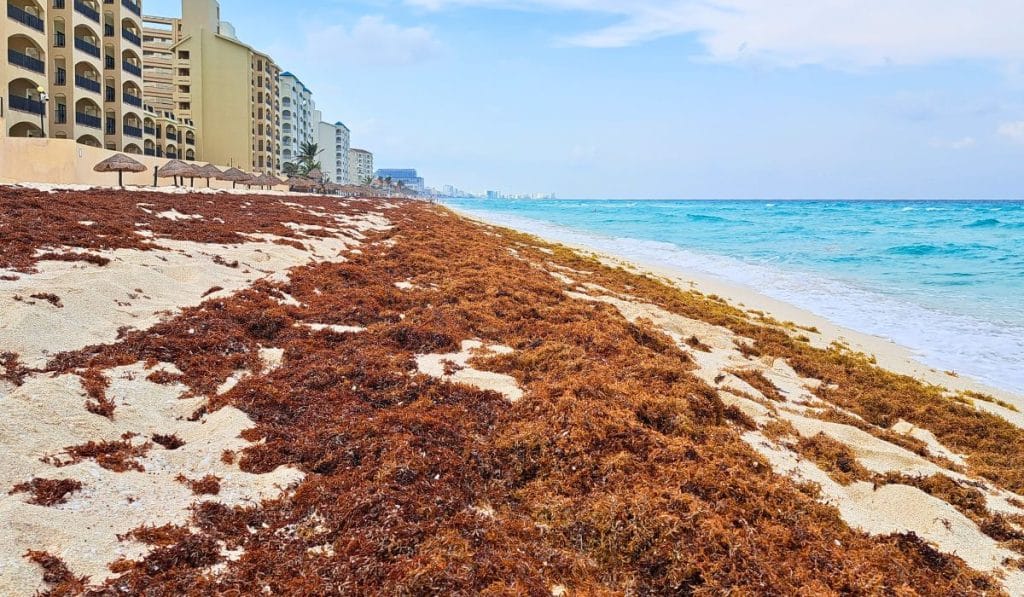Cancun To Receive Thousands Of Tons Of Sargassum In The Next Weeks, Warn Authorities
2 min readThe worst peak of sargassum is approaching and multiple beaches in Quintana Roo will be strongly impacted by disproportionate levels of algae, warned experts. From now until August, the popular Mexican state will once again receive thousands of tons of sargassum on its otherwise pristine beaches. Authorities expect “about 500 thousand tons [of sargassum], mainly in the southern municipalities, Mahahual and Xcalak, Sian Ka’an, Solidaridad, and Tulum,” reported Esteban Amaro Mauricio, head of Sargassum Monitoring Network. Take note. The most […]
The post Cancun To Receive Thousands Of Tons Of Sargassum In The Next Weeks, Warn Authorities appeared first on Traveling Lifestyle.
The worst peak of sargassum is approaching and multiple beaches in Quintana Roo will be strongly impacted by disproportionate levels of algae, warned experts.
From now until August, the popular Mexican state will once again receive thousands of tons of sargassum on its otherwise pristine beaches.
Authorities expect “about 500 thousand tons [of sargassum], mainly in the southern municipalities, Mahahual and Xcalak, Sian Ka’an, Solidaridad, and Tulum,” reported Esteban Amaro Mauricio, head of Sargassum Monitoring Network.
Take note. The most affected beaches will include Playa del Niño, Puerto Juárez, and Puerta del Mar beach in Cancun.
In summary, sargassum is expected to be especially problematic from Riviera Cancun beach (before the Moon Palace hotel) until Tulum.
This matter shouldn’t be taken lightly. In a recent report, authorities revealed the detection of a blob of more than “7,400 tons of sargassum floating on its way to Mexican beaches from the Honduran Caribbean.” The concerning discovery was made by the University of South Florida’s Optical Oceanography Laboratory.
[embedded content]
To tackle the issue, Quintana Roo’s authorities have installed some 8,600 meters of anti-sargassum barriers.
“This reinforces the labor of 22 small boats, an ocean vessel, four beach sweepers, 11 algae collectors, and eight amphibious bands to control sargassum in 2024,” according to REPORTUR.mx.
In addition, the Secretary of the Navy (Semar) has sent 22 smaller vessels to help with cleaning operations, according to El Heraldo.
One of the risks reported by multiple sources is that this biomass has the potential to double over the next 20 days due to its incredible capability to reproduce in the open sea.
This poses a problem for tourists, who will see their holidays partially ruined.
Large masses of sargassum consume great quantities of oxygen and poison the waters, suffocating hundreds of marine creatures in the process.
When there is too much sargassum in the water, it causes “anoxia and releases toxic gases like hydrogen sulfide and methane, which are dangerous to human health and responsible for the deaths of hundreds of marine species,” warned Quintana Roo’s Citizen Observatory.
Although swimming in Sargassum is not necessarily dangerous, it is no longer the best idea because the quantities currently washing ashore are, simply put, not normal.
According to Rosa Elisa Rodríguez Martínez, member of the Academic Unit of Reef Systems of the Institute of Marine Sciences and Limnology of Quintana Roo, swimming among sargassum “could be harmful to swimmers because it contains zinc, arsenic, lead and phosphorus.”




